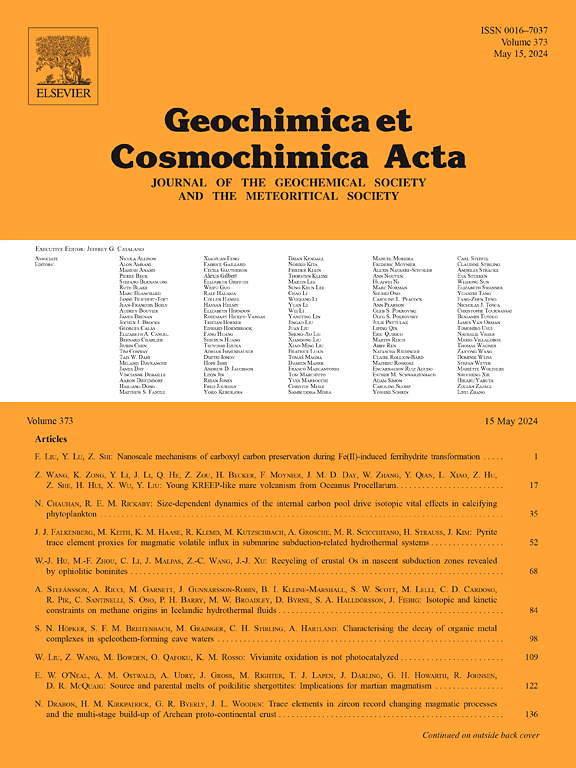弧前脱碳与弧下深度高δ26Mg流体生成的联系:来自含碳酸盐弧前蛇纹岩的约束
IF 5
1区 地球科学
Q1 GEOCHEMISTRY & GEOPHYSICS
引用次数: 0
摘要
俯冲带在地球表面和内部的碳交换中起着至关重要的作用。虽然弧前蛇纹岩的脱挥发作用被认为是弧岩浆形成的一个因素,但其在俯冲带碳(C)和镁(Mg)循环中的作用以及对全球弧熔岩中Mg同位素变化的影响仍知之甚少。研究了勉略构造区弧前橄榄岩与富co2流体相互作用过程中的Mg同位素分馏,重点研究了建察岭和梁崖子地区含碳酸盐蛇纹岩。五Jianchaling lizardite-only蛇纹岩表现出窄范围的δ26 mg值(−0.28 ±0.02 ‰−0.13 ±0.02 ‰),类似于四Jianchaling antigorite-lizardite蛇纹岩(−0.27 ±0.03 ‰−0.17 ±0.01 ‰)。7个梁崖子纯反长辉长岩的δ26Mg范围较宽(−0.27 ± 0.03 ‰~−0.01 ± 0.02 ‰)。矿物分离物的镁同位素组成揭示了碳酸盐和共沉淀蛇纹石矿物间镁同位素分选的温度依赖性。热力学模型和质量平衡计算表明,在橄榄岩与富含二氧化碳的流体相互作用过程中,从橄榄岩到流体的Mg损失最小。相反,随后的流体渗透和碳酸盐溶解是观测到的Mg同位素变化的原因。弧前重硅酸盐矿物和轻碳酸盐同时沉积,为部分弧前熔岩δ26Mg值升高提供了合理的解释。在俯冲带中,弧前板块顶部温度可超过反长岩的稳定极限(600 ~ 700 ℃),弧前脱碳作用显著,产生富含二氧化碳的流体,与地幔楔底部的弧前橄榄岩相互作用,形成丰富的同位素重硅酸盐矿物。这些硅酸盐的后续分解和在亚弧深度的有限的板源碳酸盐释放可能是这些俯冲带的高δ26Mg值和低CO2流出特征的原因。相比之下,俯冲带弧前板顶温度较低,弧前板顶温度接近反长岩的稳定极限,弧前脱碳作用较小。在这样的背景下,同位素重硅酸盐相的有限形成和板状碳酸盐在亚弧深度由于板状流体的渗透而增强的释放,可能导致δ26Mg值接近或略低于正常地幔的弧岩浆。这些发现强调了弧前区流体-岩石相互作用在调节深部碳循环和塑造弧岩浆镁同位素特征中的关键作用。本文章由计算机程序翻译,如有差异,请以英文原文为准。
Links between forearc decarbonation and generation of high δ26Mg fluids at subarc depths: constraints from carbonate-bearing forearc serpentinites
Subduction zones play a critical role in carbon exchange between Earth’s surface and interior. While devolatilization of forearc serpentinites has been proposed as a contributor to arc magma genesis, its role in subduction-zone carbon (C) and magnesium (Mg) cycling, as well as its influence on the Mg isotopic variability in global arc lavas, remains poorly constrained. This study investigates Mg isotope fractionation during interactions between forearc peridotites and CO2-rich fluids in the Mianlue tectonic mélange, focusing on carbonate-bearing serpentinites from the Jianchaling and Liangyazi regions. Five Jianchaling lizardite-only serpentinites exhibit a narrow range of δ26Mg values (−0.28 ± 0.02 ‰ to −0.13 ± 0.02 ‰), similar to those of four Jianchaling antigorite-lizardite serpentinites (−0.27 ± 0.03 ‰ to −0.17 ± 0.01 ‰). In contrast, seven Liangyazi antigorite-only serpentinites display a broader δ26Mg range (−0.27 ± 0.03 ‰ to −0.01 ± 0.02 ‰). Magnesium isotope compositions of mineral separates reveal temperature-dependent inter-mineral Mg isotope fractionations between carbonate and co-precipitated serpentine minerals. Thermodynamic modeling and mass balance calculations indicate minimal Mg loss from peridotites to fluids during their interaction with CO2-rich fluids. Instead, subsequent fluid infiltration and carbonate dissolution are responsible for the observed Mg isotopic variations. The concurrent precipitation of isotopically heavy silicate minerals and light carbonates in the forearc provides a plausible explanation for the elevated δ26Mg values observed in some arc lavas. In subduction zones where the forearc slab-top temperatures can exceed the stability limit of antigorite (600 – 700 °C), significant forearc decarbonation produces CO2-rich fluids that interact with forearc peridotites at the bottom of the mantle wedge, forming abundant isotopically heavy silicate minerals. The subsequent breakdown of these silicates and limited release of slab-derived carbonates at subarc depths may be responsible for the high δ26Mg values and low CO2 outfluxes characteristic of these subduction zones. In contrast, subduction zones with cooler forearc slab-top temperatures, where subarc slab-top temperatures approach the stability limit of antigorite, experience less significant forearc decarbonation. In such settings, limited formation of isotopically heavy silicate phases and enhanced release of slab carbonates at subarc depths due to infiltrations of slab-derived fluids can potentially result in arc magmas with δ26Mg values close to or slightly below the normal mantle. These findings underscore the critical role of fluid-rock interactions in the forearc region in regulating deep carbon cycling and shaping the Mg isotopic signatures of arc magmas.
求助全文
通过发布文献求助,成功后即可免费获取论文全文。
去求助
来源期刊

Geochimica et Cosmochimica Acta
地学-地球化学与地球物理
CiteScore
9.60
自引率
14.00%
发文量
437
审稿时长
6 months
期刊介绍:
Geochimica et Cosmochimica Acta publishes research papers in a wide range of subjects in terrestrial geochemistry, meteoritics, and planetary geochemistry. The scope of the journal includes:
1). Physical chemistry of gases, aqueous solutions, glasses, and crystalline solids
2). Igneous and metamorphic petrology
3). Chemical processes in the atmosphere, hydrosphere, biosphere, and lithosphere of the Earth
4). Organic geochemistry
5). Isotope geochemistry
6). Meteoritics and meteorite impacts
7). Lunar science; and
8). Planetary geochemistry.
 求助内容:
求助内容: 应助结果提醒方式:
应助结果提醒方式:


